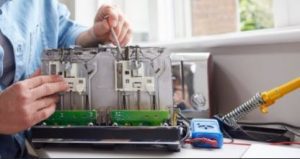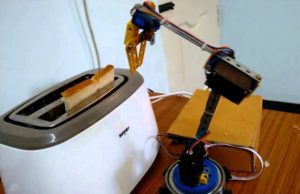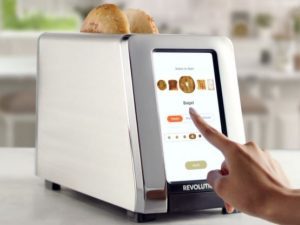As far as warehouses go, they’ve always looked to me like giant boxes. Boxes where things go in and come out – sometimes exactly as they came in, sometimes dressed differently. Similar to giant toasters – which is actually what intrigued the 6-year-old me as to what happened inside the little box (toaster) to give me the product I want (warm, toasted bread).
So… my mom found 6-year-old me one day with the toaster completely open with its “guts” on the kitchen counter trying to figure out the inner workings of this little box. This is what started my path to solution finding and system design (engineering). I took this toaster apart to better understand each piece and their value. I put the little box back together to find I left a piece out, but it still worked!
kitchen counter trying to figure out the inner workings of this little box. This is what started my path to solution finding and system design (engineering). I took this toaster apart to better understand each piece and their value. I put the little box back together to find I left a piece out, but it still worked!
Note: nothing was blown up or burnt.
Note 2: this helped my understanding of EFFICIENCY and OPTIMIZATION – words the 6-year-old me had no definitions for but would definitely need.
When it comes to your operations, facility, warehouse… “giant box,” efficiency and optimization are key words to maximizing profit – which is what keeps businesses alive.
While our job is to help clients automate, automation is mostly fit for efficient and optimized facilities. In layman’s terms, don’t look for a new toaster until you know 1what kind of bread you’re handling, 2when it’s being handled, and 3have an idea of who’s eating. These are all part of your warehouse best practices – automation prep.
Warehouse Best Practices – Part I
1. What kind of bread are you handling?
a. The other KYP – Know Your Product
If you’ve done warehousing for a while, you have an idea of the burden of costs like shipping. These can make or break a product/business if the costs aren’t optimized and minimized. To do that, you should.
i. Get a scale – rate-shopping software is a great plus but should work in tandem with an inline scale or similar, which can minimize your shipping costs.
ii. Get a dimensionalizer – it doesn’t matter if that’s not a real word, yet. The dimensionalizer is a piece of equipment that can “grab” the dimensions of your product or shipping carton and store it in your system (WMS, ERP, or similar).
iii. Optimize product locations – this can only happen if you know more information than just product weight and dimensions. Once you understand the velocity/speed of that product (item or SKU) you can determine the best location for it in your facility.
1. This is what allows some companies to have a lane for “A movers” or “fast movers”
2. “A Movers” are usually what go first in faster throughput automation
3. Knowing the “slow movers” can help keep them out of the way of “fast movers”
b. With the information above, a company can take the next step in optimization by being able to slot products and optimize operational flow.
Note: It cannot be stressed enough that dimensions and weights of your product are key to any automation endeavor. Even if you’ve no plans to automate, this data is key to improving your warehouse, operations, and operational flow.
2. When is it being handled?
a. With slotting (optimizing product locations) and efficiently laying out your operations, comes an understanding of when personnel are needed throughout the work shift and where in the facility they’re needed. The original KYP – Know Your Personnel plus a little KYL – Know Your Layout.
facility they’re needed. The original KYP – Know Your Personnel plus a little KYL – Know Your Layout.
i. Not all work requires equal talents – know where you can place workers for more repetitive or mundane tasks vs. where high-talent workers are needed.
Note: This is a great indicator of where a robot or autonomous technology may be used for future automation phases.
ii. Not all product gets picked all the time – know where you can place more workers or create dynamic work zones, flex workers, etc. that can handle changes in the day’s workload.
b. With scales, dimensionalizers, and warehouse execution software (WES or similar) products can be picked as it makes sense for shipping i.e., heavier stuff or bigger stuff on the bottom of a pallet, as well as many other customer-set preferences.
3. Who’s eating?
a. Let’s call this… KYC – Know Your Customer
My mom knew prior to the toaster fiasco that I was the inquisitive type – KYC. In this day and age, the age of the internet and shared information, comes the inquisitive customer – or the ones that want their product(s) handled a specific way.
i. If your customer doesn’t know “how they’d like their bread to come out” today, they will want the option to decide in the near future. This may come in the form of specific labels on their shipping boxes, bags or envelopes or a specific pallet configuration based on their shipment destinations, as well as an assortment of other requests; jam, butter… avocado.
destinations, as well as an assortment of other requests; jam, butter… avocado.
ii. With the internet comes the internet of things (IoT), where customers have the ability to track the bread in your toaster, and once it leaves your toaster until it arrives on their plate.
b. It’s worth noting that with the exception of IoT technology, it doesn’t take much automation to meet most customers’ needs. These best practices are to be put in place prior to the search for automation technology.
If you’re not good with remembering bread in a toaster (No’s 1-3 above) it would be good to remember KYP2, KYL, and KYC to start performing best practices within your operations – though bread just makes sense to me.
KYP2 – Know Your Product(s)/Personnel
KYL – Know Your Layout
KYC – Know Your Customer
It’s okay if you’re unsure of the next steps. Abel Womack has teams available to help you figure out if and when an automated solution can work for your organization. Contact our automation team for more.
Stay tuned for Warehouse Best Practices – Part II, where we discuss the optimal layouts and operational flows for different types of businesses. Should there be 2 slots in your toaster or 8? Are you ever handling waffles or bagels?



Leave a Reply
You must be logged in to post a comment.